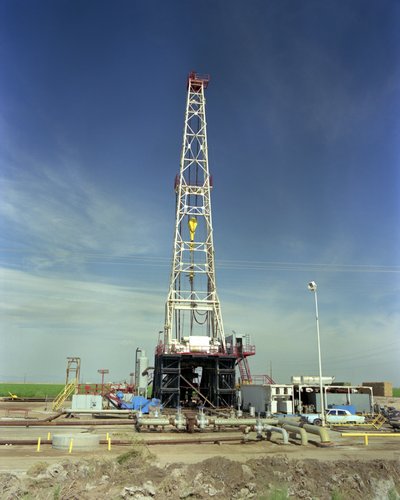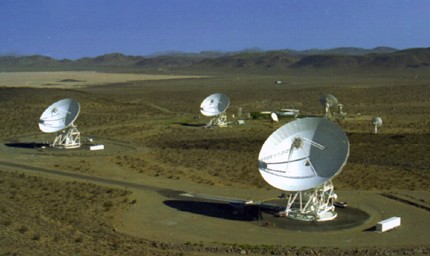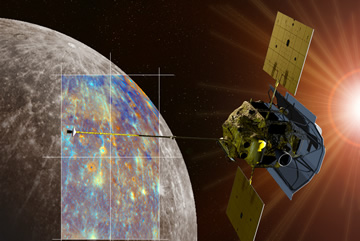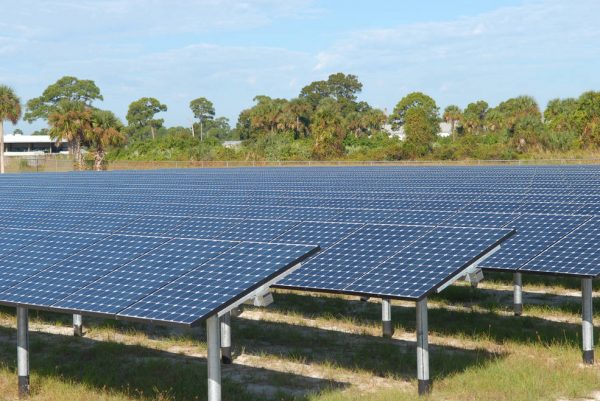Benefits
Spacecraft
Solar System Exploration
Spacecraft with high temperature, radiation hard silicon carbide (SiC) electronics will enable challenging missions in both the inner and outer solar system.
Radiation hard high temperature silicon carbide electronics will play a key role in future missions to the solar system’s most hostile environments. Long-term operation of landers on Venus’s scorching 460 °C surface will require the use of uncooled silicon carbide electronics. For spacecraft operating near the Sun, silicon carbide electronics would enable significant reductions in spacecraft shielding and heat dissipation hardware, so that more scientific instruments could be included on each vehicle. Silicon carbide’s imperviousness to both heat and radiation will enable descent probes to return data from much deeper into the atmospheres of Jupiter and Saturn.
Space nuclear power is expected to play a key role in the advanced exploration of the outer solar system. Future space nuclear power systems will require control and monitoring circuits for safe and optimum reactor performance. Use of heat-tolerant radiation hardened SiC circuits will greatly reduce the shielding needed to protect the reactor control electronics, and enable placement of the electronics in close proximity with the reactor, both of which should trim considerable weight from the power system.
Enhanced Spacecraft
Compact and lightweight silicon carbide (SiC) high efficiency power electronics will reduce spacecraft mass while increasing functional capacities, including electric propulsion missions.
It is now well-demonstrated that silicon carbide power devices can enable substantial improvements to the size, weight, and efficiency of power management and distribution circuits and systems. The faster switching speed of high-voltage silicon carbide power devices compared to similarly rated silicon power devices enables the practical use of much higher internal switching frequencies in power conversion circuits. The higher internal switching frequency in turn enables power conversion circuits to employ much smaller transformers and capacitors that are almost always the vast majority of the size and weight of a power converter circuit. While the amount of benefit is always application-specific, some silicon carbide converter demonstrations have cut the volume and weight by more than 5-fold compared to correspondingly rated converters implemented with standard silicon power devices.
Spacecraft often require thermal radiators to dissipate heat generated by the spacecraft’s functional electronics. These electronics, currently based on silicon or gallium arsenide semiconductors, would fail if they were not properly cooled by the spacecraft’s thermal radiators. Because silicon carbide electronics can operate at much higher temperatures than silicon or gallium arsenide, the size and weight of such radiators on a spacecraft could be greatly reduced or even eliminated.
The above combined silicon carbide electronics system benefits will enable substantial weight savings on spacecraft, or at least allow greater functionality (i.e., more scientific instruments or communications transponders) by utilizing the space and weight formerly occupied by the larger silicon-based power and thermal management subsystems. Given the high costs of launching payloads, the weight savings gained by using silicon carbide electronics could have large economic and competitive implications in the satellite industry.
Advanced Launch Vehicles
Silicon carbide (SiC) electronics and sensors that could function mounted in hot engine and aerosurface areas of advanced launch vehicles would enable weight savings, increased engine performance, and increased reliability.
Complex electronics and sensors are expected to enhance the capabilities and efficiency of advanced space launch vehicles. Many of these electronics and sensors monitor and control vital engine components that operate at high temperatures. Since today’s silicon-based electronics technology cannot function at high temperatures, these electronics must presently reside in environmentally controlled areas. This necessitates the use of long wire runs between the sheltered electronics and the hot-area sensors and controls or the fuel-cooling of the electronics and sensors located in high-temperature areas. Both of these low-temperature-electronics approaches suffer from significant drawbacks of added weight and increased system complexity.
A family of high temperature silicon carbide electronics and sensors that could function in hot areas of the launch vehicle would alleviate the above-mentioned technical obstacles to enable performance gains. Silicon carbide based distributed control electronics and sensors that could operate in very harsh environments would eliminate wiring and connectors needed in conventional sheltered-electronic control systems. Furthermore, uncooled operation silicon carbide high-power electronics could save launch vehicle weight by replacing hydraulic actuator systems and fluids with fluid-free electromechanical controls.
SiC-based sensors are being developed for launch vehicle applications by the NASA Glenn Gas Sensors team, as well as the NASA Glenn Physical Sensors team.
Aircraft
Advanced Control Electronics
Silicon carbide (SiC) electronics and sensors that could function mounted in hot engine and aerosurface areas of advanced aircraft would enable substantial weight savings, increased jet engine performance, and increased reliability.
 Complex electronics and sensors are increasingly relied on to enhance the capabilities and efficiency of modern jet aircraft. Many of these electronics and sensors monitor and control vital engine components and aerosurfaces that operate at high temperatures.
Complex electronics and sensors are increasingly relied on to enhance the capabilities and efficiency of modern jet aircraft. Many of these electronics and sensors monitor and control vital engine components and aerosurfaces that operate at high temperatures.
However, since today’s silicon-based electronics technology cannot function at high temperatures, these electronics must reside in environmentally controlled areas. This necessitates the use of long wire runs between the sheltered electronics and the hot-area sensors and controls or the fuel-cooling of the electronics and sensors located in high-temperature areas. Both of these low-temperature-electronics approaches suffer from serious drawbacks, as the wire runs add a substantial amount of weight, fuel cooling has harmed aircraft fuel efficiency, and both have negatively impacted aircraft reliability.
A family of high temperature silicon carbide electronics and sensors that could function in hot areas of the aicraft would alleviate the above-mentioned technical obstacles to enable substantial aircraft performance gains. Some aircraft design studies have indicated that harsh-environment silicon carbide based distributed control electronics could eliminate the majority the wiring and connectors that are otherwise needed in conventional sheltered-electronics aircaft control systems. This is extremely crucial given the fact that wiring and connector problems are the most frequent cause of propulsion maintenance action and downtime in commercial aircraft today. In addition, uncooled operation of silicon carbide power electronics could also save weight and increase reliability by replacing hydraulic controls and fluids with “smart” fluid-free electromechanical controls. Even in non-hot areas of an aircraft, silicon carbide electronics would enable the elimination of electronics cooling systems, such as the liquid cooling system employed in the F-22, that add weight and reduce operational reliability of high-performance aircraft.
Improved Electric Aircraft
Silicon carbide (SiC) power electronics enable drastic reductions in power converter size while increasing conversion efficiency, both of which are critical to future electric aircraft performance improvements. SiC power devices are therefore crucial to NASA’s development of Electrified Aircraft Propulsion aimed at reducing fuel consumption and carbon emissions.
Power semiconductor devices are a critical element electric power conversion and distribution systems. SiC power devices are being demonstrated to greatly improve the efficiency and size performance of power converters compared to silicon. In short, SiC power devices standoff higher voltages with lower parasitic resistances faster switching than silicon power devices. Faster switching speed increases power conversion efficiency, and also enables the use of smaller transformers and capacitors to greatly shrink the overall size and weight of the system (which is critical in aircraft). Furthermore, the high temperature capability of SiC greatly reduces cooling requirements can also detrimentally add size and weight to electric aircraft.
Power
Public & Renewable Power Distribution
Superior silicon carbide (SiC) power electronics could increase the efficiency and reliability of the public electric power distribution system.
 Energy utilities generate more electricity than is consumed at any given time. This excess power reserve is needed to cover losses that occur in electric power transmission, including losses that accumulate during conversion of electricity to and from very different voltages used throughout the power grid. Excess power reserve is also needed to ensure that electric service is reliably immune to everyday load changes and component failures that cause electrical glitches throughout the power grid. With increasing reliance on renewable energy, the incorporation of more efficient silicon carbide power conversion electronics into the power grid should significantly reduce the power reserve margin necessary for reliable operation.
Energy utilities generate more electricity than is consumed at any given time. This excess power reserve is needed to cover losses that occur in electric power transmission, including losses that accumulate during conversion of electricity to and from very different voltages used throughout the power grid. Excess power reserve is also needed to ensure that electric service is reliably immune to everyday load changes and component failures that cause electrical glitches throughout the power grid. With increasing reliance on renewable energy, the incorporation of more efficient silicon carbide power conversion electronics into the power grid should significantly reduce the power reserve margin necessary for reliable operation.
SiC-enabled reductions in size and cost energy conversion circuits are accelerating adoption of solar and wind renewable energy.
Power semiconductor devices are a critical element of “smart” electric power conversion and distribution systems. While the vast majority of these devices are presently implemented in conventional silicon-based semiconductor technology, it is increasingly clear that SiC power devices can greatly improve the efficiency and size performance of these systems. In short, SiC power devices could standoff higher voltages and respond faster using devices with lower parasitic resistances and physically sizes much smaller than silicon power devices. Faster switching speed not only increases power system conversion efficiency, but it also enables the use of smaller transformers and capacitors to greatly shrink the overall size and weight of the system which in turn makes solar and wind renewables easier and lest costly to install. Furthermore, the high temperature capability of SiC greatly reduces cooling requirements that are also a substantial portion of the total size and cost of a power conversion and distribution system. SiC devices are therefore expected to drastically improve the distribution and efficient usage of electric power throughout the 21st century.
Automotive
Hybrid and Electric Vehicles
Silicon carbide (SiC) will enable more practical electric vehicles and other transportation systems.
The capabilities of electric vehicles are largely determined by the capabilities of the electric circuits and motors that are responsible for converting electrical energy into drivetrain energy. SiC power devices are being demonstrated to greatly improve the efficiency and size performance of electric automotive power converters compared to silicon. In short, SiC power devices standoff higher voltages with lower parasitic resistances faster switching than silicon power devices. Faster switching speed increases power conversion efficiency, and also enables the use of smaller transformers and capacitors to greatly shrink the overall size and weight. Furthermore, the high temperature capability of SiC greatly reduces cooling requirements can also detrimentally add size and weight to the vehicle. In addition to electric automobiles, superior SiC power conversion electronics would enhance the performance of most any form of electric-motor transportation system, from mass transit trains and busses to commercial railroad locomotives to commercial and military surface ships and submarines. SiC power devices are also being utilized to improve efficiency and charging times of electric vehicle charging stations.
Combustion Control
Silicon carbide (SiC) high-temperature electronic sensors and controls on an automobile engine will lead to better combustion monitoring and control, which would result in cleaner burning, more fuel-efficient cars.
 Internal combustion automobiles are increasingly relying on complex “under-the-hood” electronics and sensors rated at temperatures from -40 °C to 125 °C to meet the demands for increasing fuel efficiency while decreasing pollutant emissions. Careful placement of silicon-based engine control electronics boxes within the engine compartment presently meets most of today’s automotive needs. However, integratedSiC sensors functioning directly in contact with higher temperature cylinder head and exhaust pipe areas would enable further gains in fuel combustion efficiency and reduced exhaust emissions. Furthermore, SiC-based engine control electronics rated at temperatures well above 125 °C would eliminate present-day box placement design constraints and would reduce the number of wires and connectors in the engine, both of which should improve long-term reliability.
Internal combustion automobiles are increasingly relying on complex “under-the-hood” electronics and sensors rated at temperatures from -40 °C to 125 °C to meet the demands for increasing fuel efficiency while decreasing pollutant emissions. Careful placement of silicon-based engine control electronics boxes within the engine compartment presently meets most of today’s automotive needs. However, integratedSiC sensors functioning directly in contact with higher temperature cylinder head and exhaust pipe areas would enable further gains in fuel combustion efficiency and reduced exhaust emissions. Furthermore, SiC-based engine control electronics rated at temperatures well above 125 °C would eliminate present-day box placement design constraints and would reduce the number of wires and connectors in the engine, both of which should improve long-term reliability.
The NASA Glenn Chemical Species Gas Sensors team is developing SiC-based high-temperature gas sensors for automotive applications.
Energy Production
Deep-Well Drilling
Silicon carbide’s ability to function in hotter environments will facilitate safer and more efficient drilling of deeper oil, natural gas, and geothermal energy production wells.
 The drilling of today’s energy production wells rely on silicon-based semiconductor electronics and sensors at the drill head to provide critical guiding information about the physical status of the head as well as the rock formations being drilled. As energy production demands continue to drive drilling towards greater depths and faster drilling rates, drill-head operating temperatures are expected to rise beyond the operational limits of silicon. Silicon carbide sensors and circuits are expected to enable critical telemetry capability at drill-head temperatures greater than 300 °C expected in future drilling of energy production wells.
The drilling of today’s energy production wells rely on silicon-based semiconductor electronics and sensors at the drill head to provide critical guiding information about the physical status of the head as well as the rock formations being drilled. As energy production demands continue to drive drilling towards greater depths and faster drilling rates, drill-head operating temperatures are expected to rise beyond the operational limits of silicon. Silicon carbide sensors and circuits are expected to enable critical telemetry capability at drill-head temperatures greater than 300 °C expected in future drilling of energy production wells.
Communications & Radar
Radio Frequency (RF) Devices
Silicon carbide (SiC) enables higher-power high-frequency RF electronics offering significant improvements to wireless communications and radar systems.
 Military aircraft desire solid-state microwave electronics operating at higher powers and temperatures than is theoretically possible with silicon and gallium arsenide semiconductor devices. Silicon carbide has therefore been developed and deployed into high-power RF systems, including defense-related radar systems.
Military aircraft desire solid-state microwave electronics operating at higher powers and temperatures than is theoretically possible with silicon and gallium arsenide semiconductor devices. Silicon carbide has therefore been developed and deployed into high-power RF systems, including defense-related radar systems.
Silicon carbide wafers also serve as a beneficial substrates for manufacturing gallium nitride based RF electronics that are playing a key role in today’s expanding wireless communications society, including 5G cell phone/data, air traffic control, radar, etc.




